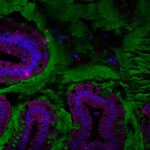Link to Pubmed [PMID] – 23104802
Link to DOI – 10.1128/JB.01079-12
J Bacteriol 2013 Jan; 195(1): 76-84
Ileal lesions of patients with Crohn’s disease are colonized by adherent-invasive Escherichia coli (AIEC) bacteria that are able to adhere to and invade intestinal epithelial cells (IEC), to replicate within macrophages, and to form biofilm. Clinical observations showed that bacterial biofilms were associated with the mucosa of inflammatory bowel disease patients. In the present study, we analyzed the relationship between AIEC colonization of the gut and the formation of biofilm, focusing on the involvement of the σ(E) pathway in the AIEC-IEC interaction. We observed that σ(E) pathway inhibition in AIEC reference strain LF82 led to an impaired ability to adhere to and invade IEC but also induced a large decrease in the abilities to colonize the intestinal mucosa and form biofilm. This indicates that targeting of the σ(E) pathway could be a very potent therapeutic strategy by which to interfere with the ability of AIEC to form biofilm on the gut mucosa of Crohn’s disease patients.


